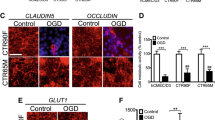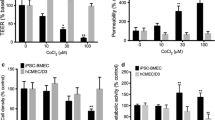Abstract
Ischemia–reperfusion leads to increased levels at the blood–brain barrier of the multidrug efflux transporter, P-glycoprotein that provides protection to the brain by limiting access of unwanted substances. This is coincident with the production of nitric oxide. This present study using immortalized rat brain endothelial cells (GPNTs) examines whether following hypoxia-reoxygenation, nitric oxide contributes to the alterations in P-glycoprotein levels. After 6 h of hypoxia, both nitric oxide and reactive oxygen species, detected intracellularly using fluorescent monitoring dyes, were produced in the subsequent reoxygenation phase coincident with increased P-glycoprotein. The evidence that nitric oxide can directly affect P-glycoprotein expression was sought by applying S-nitroso-N-acetyl-dl-penicillamine that as shown increased the nitric oxide generation. Sodium nitroprusside, though more effective at increasing P-glycoprotein expression, appeared to produce different reactive species. Real time RT-PCR analysis revealed the predominant form of nitric oxide synthase in these cells to be endothelial, inhibition of which partially prevented the increase in P-glycoprotein during reoxygenation. These data indicate that the production of nitric oxide by endothelial nitric oxide synthase during reoxygenation can influence P-glycoprotein expression in cells of the blood-rat brain barrier, highlighting another route by which nitric oxide may protect the brain.



Similar content being viewed by others
Abbreviations
- BSA:
-
Bovine serum albumin
- DCF-DA:
-
2′,7′-Dichlorodihydrofluorescein diacetate
- DAF-FM-DA:
-
4-Amino-5-methylamino-2′,7′-difluorofluorescein diacetate
- EDTA:
-
Ethylenediaminetetraacetic acid
- HR:
-
Hypoxia-reoxygenation
- GAPDH:
-
Glyceraldehyde-3-phosphate dehydrogenase
- HBSS:
-
Hanks balanced salt solution
- HPRT:
-
Hypoxanthine-guanine phosphoribosyl transferase
- l-NAME:
-
N5-[imino(nitroamino)methyl]-l-ornithine, methyl ester, monohydrochloride
- l-NIO:
-
N (5)-(1-iminoethyl)-l-ornithine
- MCAO:
-
Middle cerebral artery occlusion
- NO• :
-
Nitric oxide
- eNOS:
-
Endothelial nitric oxide synthase
- PBS:
-
Phosphate buffered saline
- PEG:
-
Polyethylene glycol
- P-gp:
-
P-glycoprotein
- ROS:
-
Reactive oxygen species
- RT-PCR:
-
Reverse transcriptase-polymerase chain reaction
- SNAP:
-
S-nitrosothiol S-nitroso-N-acetyl-dl-penicillamine
- SNP:
-
Sodium nitroprusside
References
Abbott NJ (2002) Astrocyte-endothelial interactions and blood-brain barrier permeability. J Anat 200(6):629–638
Balcerczyk A, Soszynski M, Bartosz G (2005) On the specificity of 4-amino-5-methylamino-2’,7’,-difluorofluorescein as a probe for nitric oxide. Free Radic Biol Med 39(3):327–335
Bauer B, Hartz AM, Miller DS (2007) Tumor necrosis factor alpha and endothelin-1 increase P-glycoprotein expression and transport activity at the blood-brain barrier. Mol Pharmacol 71(3):667–675
Crow JP (1997) Dichlorodihydrofluorescein and dihydrorhodamine 123 are sensitive indicators of peroxynitrite in vitro: implications for intracellular measurement of reactive nitrogen and oxygen species. Nitric Oxide 1(2):145–157
Dawson VL, Kizushi VM, Huang PL, Snyder SH, Dawson TM (1996) Resistance to neurotoxicity in cortical cultures from neuronal nitric oxide synthase-deficient mice. J Neurosci 16(8):2479–2487
Dixit SG, Zingarelli B, Buckley DJ, Buckley AR, Pauletti GM (2005) Nitric oxide mediates increased P-glycoprotein activity in interferon-{gamma}-stimulated human intestinal cells. Am J Physiol Gastrointest Liver Physiol 288(3):G533–G540
Dudzinski D, Michel T (2007) Life history of eNOS: partners and pathways. Cardiovasc Res 75(2):247–260
Felix RA, Barrand MA (2002) P-glycoprotein expression in rat brain endothelial cells: evidence for regulation by transient oxidative stress. J Neurochem 80(1):64–72
Ferriero DM, Holtzman DM, Black SM, Sheldon RA (1996) Neonatal mice lacking neuronal nitric oxide synthase are less vulnerable to hypoxic-ischemic injury. Neurobiol Dis 3(1):64–71
Greenwood J, Pryce G, Devine L, Male DK, dos Santos WL, Calder VL, Adamson P (1996) SV40 large T immortalised cell lines of the rat blood-brain and blood-retinal barriers retain their phenotypic and immunological characteristics. J Neuroimmunol 71(1–2):51–63
Hermann DM, Kilic E, Spudich A, Kramer SD, Wunderli-Allenspach H, Bassetti CL (2006) Role of drug efflux carriers in the healthy and diseased brain. Ann Neurol 60(5):489–498
Huang Z, Huang PL, Ma J, Meng W, Ayata C, Fishman MC, Moskowitz MA (1996) Enlarged infarcts in endothelial nitric oxide synthase knockout mice are attenuated by nitro-l-arginine. J Cereb Blood Flow Metab 16(5):981–987
Iadecola C, Zhang F, Xu S, Casey R, Ross ME (1995) Inducible nitric oxide synthase gene expression in brain following cerebral ischemia. J Cereb Blood Flow Metab 15(3):378–384
Iadecola C, Zhang F, Casey R, Nagayama M, Ross ME (1997) Delayed reduction of ischemic brain injury and neurological deficits in mice lacking the inducible nitric oxide synthase gene. J Neurosci 17(23):9157–9164
Kader A, Frazzini VI, Solomon RA, Trifiletti RR (1993) Nitric oxide production during focal cerebral ischemia in rats. Stroke 24(11):1709–1716
Lo EH, Hara H, Rogowska J, Trocha M, Pierce AR, Huang PL, Fishman MC, Wolf GL, Moskowitz MA (1996) Temporal correlation mapping analysis of the hemodynamic penumbra in mutant mice deficient in endothelial nitric oxide synthase gene expression. Stroke 27(8):1381–1385
Maeng HJ, Kim MH, Jin HE, Shin SM, Tsuruo T, Kim SG, Kim DD, Shim CK, Chung SJ (2007) Functional induction of P-glycoprotein in the blood-brain barrier of streptozotocin-induced diabetic rats: evidence for the involvement of nuclear factor-kappaB, a nitrosative stress-sensitive transcription factor, in the regulation. Drug Metab Dispos 35(11):1996–2005
Malinski T, Bailey F, Zhang ZG, Chopp M (1993) Nitric oxide measured by a porphyrinic microsensor in rat brain after transient middle cerebral artery occlusion. J Cereb Blood Flow Metab 13(3):355–358
Nakatsubo N, Kojima H, Kikuchi K, Nagoshi H, Hirata Y, Maeda D, Imai Y, Irimura T, Nagano T (1998) Direct evidence of nitric oxide production from bovine aortic endothelial cells using new fluorescence indicators: diaminofluoresceins. FEBS Lett 427(2):263–266
Nwaozuzu OM, Sellers LA, Barrand MA (2003) Signalling pathways influencing basal and H(2)O(2)-induced P-glycoprotein expression in endothelial cells derived from the blood-brain barrier. J Neurochem 87(4):1043–1051
Parmentier S, Bohme GA, Lerouet D, Damour D, Stutzmann JM, Margaill I, Plotkine M (1999) Selective inhibition of inducible nitric oxide synthase prevents ischaemic brain injury. Br J Pharmacol 127(2):546–552
Regina A, Romero IA, Greenwood J, Adamson P, Bourre JM, Couraud PO, Roux F (1999) Dexamethasone regulation of P-glycoprotein activity in an immortalized rat brain endothelial cell line, GPNT. J Neurochem 73(5):1954–1963
Robertson SJ, Kania KD, Hladky SB, Barrand MA (2009) P-glycoprotein expression in immortalised rat brain endothelial cells: comparisons following exogenously applied hyrdogen peroxide and after hypoxia-reoxygenation. J Neurochem 111(1):132–141
Schinkel AH, Smit JJ, van Tellingen O, Beijnen JH, Wagenaar E, van Deemter L, Mol CA, van der Valk MA, Robanus-Maandag EC, te Riele HP, Berns AJM, Borst P (1994) Disruption of the mouse mdr1a P-glycoprotein gene leads to a deficiency in the blood-brain barrier and to increased sensitivity to drugs. Cell 77(4):491–502
Spudich A, Kilic E, Xing H, Kilic U, Rentsch KM, Wunderli-Allenspach H, Bassetti CL, Hermann DM (2006) Inhibition of multidrug resistance transporter-1 facilitates neuroprotective therapies after focal cerebral ischemia. Nat Neurosci 9(4):487–488
Terwel D, Nieland LJM, Schutte B, Reutelingsperger CPM, Ramaekers FCS, Steinbusch HWM (2000) S-nitroso-N-acetylpenicillamine and nitroprusside induce apoptosis in a neuronal cell line by the production of different reactive molecules. Eur J Pharmacol 400(1):19–33
Wei G, Dawson VL, Zweier JL (1999) Role of neuronal and endothelial nitric oxide synthase in nitric oxide generation in the brain following cerebral ischemia. Biochim Biophys Acta 1455(1):23–34
Zhang Y, Lu J, Shi J, Lin X, Dong J, Zhang S, Liu Y, Tng Q (2008) Central administration of angiotensin-(1–7) stimulates nitric oxide release and upregulates the endothelial nitric oxide synthase expression following focal cerebral ischemia/reperfusion in rats. Neuropeptides 42(5–6):593–600
Acknowledgments
During the execution of this study, SJR held a BBSRC studentship, RNM was in receipt of a Gates Scholarship, and ASG received an Erasmus exchange studentship. The authors declare no conflict of interest.
Author information
Authors and Affiliations
Corresponding author
Rights and permissions
About this article
Cite this article
Robertson, S.J., Mokgokong, R., Kania, K.D. et al. Nitric Oxide Contributes to Hypoxia-Reoxygenation-Induced P-Glycoprotein Expression in Rat Brain Endothelial Cells. Cell Mol Neurobiol 31, 1103–1111 (2011). https://doi.org/10.1007/s10571-011-9711-4
Received:
Accepted:
Published:
Issue Date:
DOI: https://doi.org/10.1007/s10571-011-9711-4




